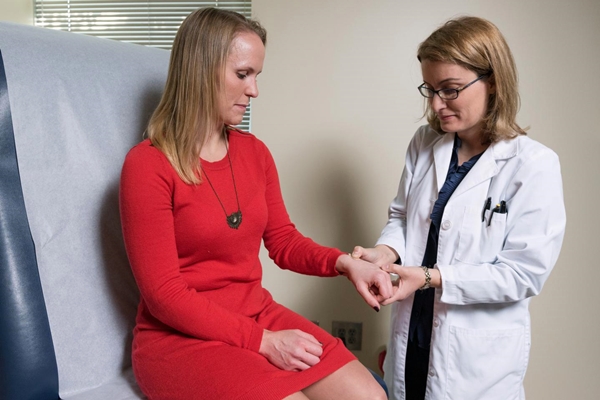
Nadine Rouphael, right, applies microneedle flu patch to study participant. (Rob Felt, Georgia Tech)
28 June 2017. A patch to deliver flu vaccine with tiny painless needles worn like a band-aid was shown in a clinical trial to be safe and produce an immune response. Results of the study, by researchers from Emory University and Georgia Institute of Technology in Atlanta, appear in yesterday’s issue of the journal The Lancet (paid subscription required).
The team led by Emory medical professor Nadine Rouphael and Georgia Tech engineering faculty Mark Prausnitz is seeking faster and more convenient ways to vaccinate large populations against seasonal flu outbreaks. Centers for Disease Control and Prevention says since 2010, as many as 60.8 million people in the U.S. get the flu each year, resulting in up to 710,000 hospitalizations and 56,000 deaths. Nonetheless, only about 40 percent of adults get vaccinated against seasonal flu, due in part to the time needed and inconvenience of a medical appointment to receive the vaccine, and discomfort of a hypodermic needle.
Prausnitz’s biomedical engineering lab at Georgia Tech that studies drug delivery processes developed the patch as an alternative to the syringe. The coin-size patch contains 100 tiny needless, long enough to enter the outer layers of skin, but not deep enough to cause pain. The inside of the patch contains adhesive to stay on the skin for a few minutes, enough time for the vaccine in the needles to enter the blood stream, but also for the needles to dissolve. After a few minutes, the patch can be removed and discarded in regular trash; special medical waste disposal is not needed.
The clinical trial, the first study of the patch in humans, recruited 100 adult volunteers at an Emory University clinic who had not yet received a seasonal flu vaccine. Participants were randomly assigned to 1 of 4 groups:
– Receive the seasonal flu vaccine covering 3 flu strains on a patch from a clinician
– Receive the same vaccine on a patch, applied by the participant
– Receive the vaccine with a syringe from a clinician
– Receive a placebo patch, with no vaccine
The clinical study team, led by Rouphael, looked primarily at the patch’s safety and tolerability, particularly reactions to the patch where placed on the skin, for the following 7 days, as well as any adverse health effects in the next 6 months. The researchers also measured concentrations of flu antibodies in the blood of participants, indicating the extent of immune system reactions to the vaccine for the next 28 days.
The results show antibody concentrations for the 3 flu strains in participants receiving the patch were similar to concentrations in individuals receiving the vaccine by a syringe, with similar results also found between the clinician- and self-administered patches. In addition, all vaccine recipients had higher antibody concentrations than placebo recipients.
The numbers of adverse effects during the trial were similar across the groups. Skin reactions to the patch, mainly tenderness or pain, were largely mild and transient. No serious treatment-related adverse effects were reported.
“Despite the recommendation of universal flu vaccination, influenza continues to be a major cause of illness leading to significant morbidity and mortality,” says Rouphael in a joint university statement. “Having the option of a flu vaccine that can be easily and painlessly self-administered could increase coverage and protection by this important vaccine.”
Rouphael and Prausnitz tell more about the patch in the following video.
- Commercial-Scale Flu Vaccine Produced in Cell Cultures
- Small Business Grant Funds Flu Therapy R&D
- Common Antibodies Found for Multi-Virus Flu Vaccine
- St. Jude Hospital to Test Nanotech Flu Virus Drugs
- Influenza A Therapy Shown Working in Trial
* * *

 RSS - Posts
RSS - Posts
You must be logged in to post a comment.